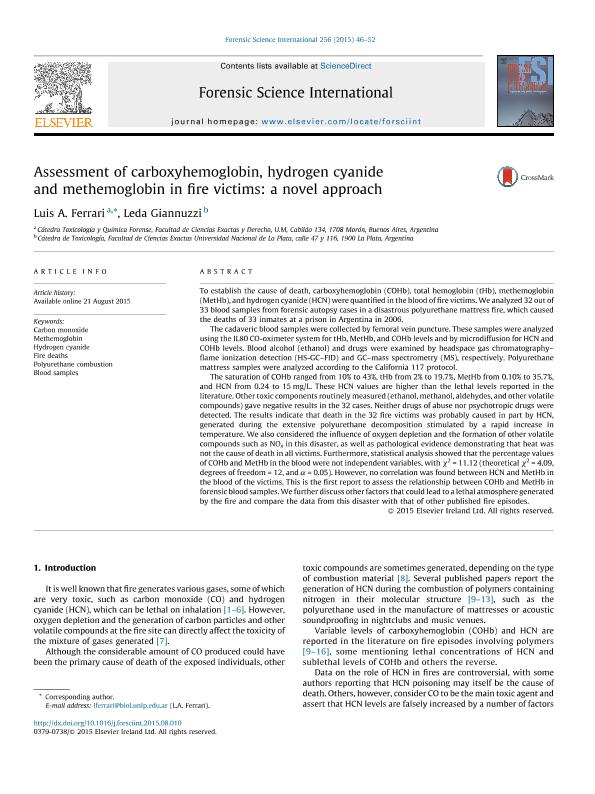Mostrar el registro sencillo del ítem
dc.contributor.author
Ferrari, Luis A.
dc.contributor.author
Giannuzzi, Leda

dc.date.available
2018-06-18T15:30:21Z
dc.date.issued
2015-11
dc.identifier.citation
Ferrari, Luis A.; Giannuzzi, Leda; Assessment of carboxyhemoglobin, hydrogen cyanide and methemoglobin in fire victims: A novel approach; Elsevier Ireland; Forensic Science International; 256; 11-2015; 46-52
dc.identifier.issn
0379-0738
dc.identifier.uri
http://hdl.handle.net/11336/48982
dc.description.abstract
To establish the cause of death, carboxyhemoglobin (COHb), total hemoglobin (tHb), methemoglobin (MetHb), and hydrogen cyanide (HCN) were quantified in the blood of fire victims. We analyzed 32 out of 33 blood samples from forensic autopsy cases in a disastrous polyurethane mattress fire, which caused the deaths of 33 inmates at a prison in Argentina in 2006. The cadaveric blood samples were collected by femoral vein puncture. These samples were analyzed using the IL80 CO-oximeter system for tHb, MetHb, and COHb levels and by microdiffusion for HCN and COHb levels. Blood alcohol (ethanol) and drugs were examined by headspace gas chromatography-flame ionization detection (HS-GC-FID) and GC-mass spectrometry (MS), respectively. Polyurethane mattress samples were analyzed according to the California 117 protocol. The saturation of COHb ranged from 10% to 43%, tHb from 2% to 19.7%, MetHb from 0.10% to 35.7%, and HCN from 0.24 to 15mg/L. These HCN values are higher than the lethal levels reported in the literature. Other toxic components routinely measured (ethanol, methanol, aldehydes, and other volatile compounds) gave negative results in the 32 cases. Neither drugs of abuse nor psychotropic drugs were detected. The results indicate that death in the 32 fire victims was probably caused in part by HCN, generated during the extensive polyurethane decomposition stimulated by a rapid increase in temperature. We also considered the influence of oxygen depletion and the formation of other volatile compounds such as NOx in this disaster, as well as pathological evidence demonstrating that heat was not the cause of death in all victims. Furthermore, statistical analysis showed that the percentage values of COHb and MetHb in the blood were not independent variables, with χ2=11.12 (theoretical χ2=4.09, degrees of freedom=12, and α=0.05). However, no correlation was found between HCN and MetHb in the blood of the victims. This is the first report to assess the relationship between COHb and MetHb in forensic blood samples. We further discuss other factors that could lead to a lethal atmosphere generated by the fire and compare the data from this disaster with that of other published fire episodes.
dc.format
application/pdf
dc.language.iso
eng
dc.publisher
Elsevier Ireland

dc.rights
info:eu-repo/semantics/openAccess
dc.rights.uri
https://creativecommons.org/licenses/by-nc-sa/2.5/ar/
dc.subject
Blood Samples
dc.subject
Carbon Monoxide
dc.subject
Fire Deaths
dc.subject
Hydrogen Cyanide
dc.subject
Methemoglobin
dc.subject
Polyurethane Combustion
dc.subject.classification
Otras Ciencias Biológicas

dc.subject.classification
Ciencias Biológicas

dc.subject.classification
CIENCIAS NATURALES Y EXACTAS

dc.title
Assessment of carboxyhemoglobin, hydrogen cyanide and methemoglobin in fire victims: A novel approach
dc.type
info:eu-repo/semantics/article
dc.type
info:ar-repo/semantics/artículo
dc.type
info:eu-repo/semantics/publishedVersion
dc.date.updated
2018-06-18T13:29:13Z
dc.journal.volume
256
dc.journal.pagination
46-52
dc.journal.pais
Irlanda

dc.journal.ciudad
Limerick
dc.description.fil
Fil: Ferrari, Luis A.. Universidad de Morón; Argentina
dc.description.fil
Fil: Giannuzzi, Leda. Provincia de Buenos Aires. Gobernación. Comisión de Investigaciones Científicas. Centro de Investigación y Desarrollo en Criotecnología de Alimentos. Consejo Nacional de Investigaciones Científicas y Técnicas. Centro Científico Tecnológico Conicet - La Plata. Centro de Investigación y Desarrollo en Criotecnología de Alimentos. Universidad Nacional de La Plata. Facultad de Ciencias Exactas. Centro de Investigación y Desarrollo en Criotecnología de Alimentos; Argentina
dc.journal.title
Forensic Science International

dc.relation.alternativeid
info:eu-repo/semantics/altIdentifier/doi/http://dx.doi.org/10.1016/j.forsciint.2015.08.010
dc.relation.alternativeid
info:eu-repo/semantics/altIdentifier/url/https://www.sciencedirect.com/science/article/pii/S0379073815003540
Archivos asociados
